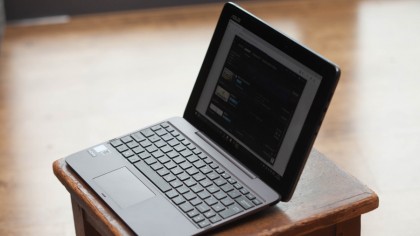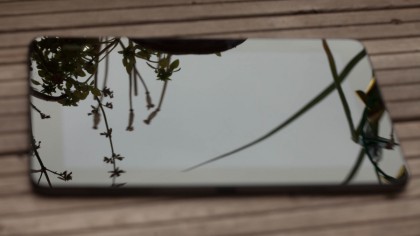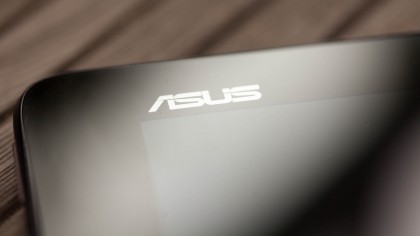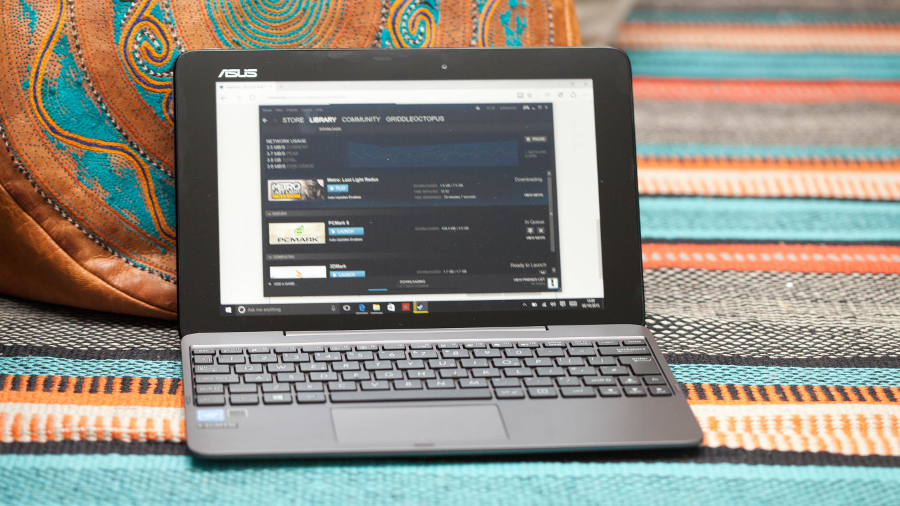Why you can trust TechRadar
The Asus isn't a fast starter and it doesn't handle everyday tasks well. It's fine for browsing the web, if a little slow, and the sluggishness gives it a slight input lag, meaning you can find yourself waiting for the smallest things. At least Windows 10 recognised when it was changing mode every time, and suggested a change to the tablet interface.
The speakers are fine here, producing an acceptable if tinny sound. What was worrying, though, was that we couldn't get the microphone to work on some of our Skype calls (though that might be a problem caused by the increasingly unreliable Skype), and that for some reason the tablet turned the front camera video image upside down – which we could do nothing about at all.

Benchmarks
The Asus Transformer T100HA I tested came with Windows 10 Home, an Intel Atom CPU clocked at 1.44GHz, 2GB of RAM and a 64GB eMMC drive.
Here's how it performed in our suite of benchmark tests:
- 3DMark: Cloud Gate: 1,953; Sky Diver: 1,044; Fire Strike: 253; Ice Storm: 21,516
- Cinebench R15: CPU: 125 points; Graphics: 12.14 fps
- PCMark 8 Home Test: 1,659 points
- PCMark 8 Battery Life: 5 hours 28 minutes
Let's just remind ourselves how that compares to the 2013 model's scores:
- Cinebench R11: CPU: 1.09 points; OpenGL: 6.09 fps
- 3DMark: Cloud Gate: 1, 222; Fire Strike: Would not run; Ice Storm: 15,842
And a further comparison to the more recent ultra-slim and hi-res Transformer Chi:
- 3DMark: Cloud Gate: 1,404; Sky Diver: 562; Fire Strike: Would not run
- Cinebench R11: CPU: 1.44pts; GPU: 6.94 fps
- Cinebench R11.5 GPU: 6.94 fps
- PCMark 8 Home Test: 1,217
- PC Mark 8 Battery Life: 8 hours 38 minutes
So, yeah. You're not going to be running anything intensive on this, save perhaps for extremely low-poly mobile games. Some of its scores were so low 3DMark couldn't find any lower reference devices. 3D graphics isn't the only thing that it struggles with – before we even got to do the Cinebench benchmarks, it took an age for the Transformer just to unzip the Cinebench download file. Hilariously, we couldn't run the Shadow of Mordor benchmark because it was, by itself, the size of the entire eMMC drive.
That battery life is much lower than the claimed 12 hours of video – but processor or 3D intensive tasks seemed to eat into the battery much faster. Given the lengthy charging times, that's not something you want to happen, lest this device be permanently bound to a plug-socket.
Despite all that, it is an improvement on the 2013 model. (But things were simpler back then). It does have passable benchmark scores for the home and office operations, and ran video and Skype smoothly, alongside other apps and open tabs. And it can still run other Windows software, which the equivalent Chromebook won't be able to do.

Display
The resolution is, simply, a bit rubbish. 1,280 x 800 is less than most mobile phones and when you glance over at the T100 Chi with that 1,920 x 1,200 retina-level screen, you feel like maybe you should spend that extra £100 (around $150, or AU$210). Elsewhere, a cheap Chromebook or Netbook can be picked up with a 1080p screen without looking very hard at all.
That said, the 10.1-inch IPS screen of the Transformer does produce some nice colours and glossy blacks. The viewing angles are also perfectly good – not that many people will be clustering around a screen this small.
The cameras were disappointing. Neither seemed good in low light and the front camera consistently displayed us as upside-down, despite our best efforts to fix this. At least there is a rear camera now, which is an improvement on the dreadful 2013 model.

